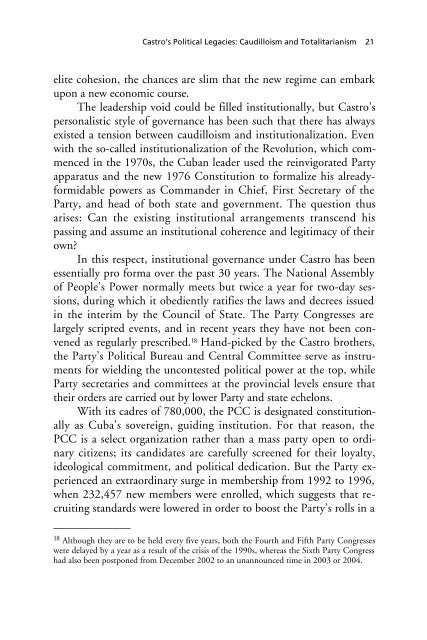Cuba After Castro - RAND Corporation
Cuba After Castro - RAND Corporation
Cuba After Castro - RAND Corporation
Create successful ePaper yourself
Turn your PDF publications into a flip-book with our unique Google optimized e-Paper software.
<strong>Castro</strong>’s Political Legacies: Caudilloism and Totalitarianism 21<br />
elite cohesion, the chances are slim that the new regime can embark<br />
upon a new economic course.<br />
The leadership void could be filled institutionally, but <strong>Castro</strong>’s<br />
personalistic style of governance has been such that there has always<br />
existed a tension between caudilloism and institutionalization. Even<br />
with the so-called institutionalization of the Revolution, which commenced<br />
in the 1970s, the <strong>Cuba</strong>n leader used the reinvigorated Party<br />
apparatus and the new 1976 Constitution to formalize his alreadyformidable<br />
powers as Commander in Chief, First Secretary of the<br />
Party, and head of both state and government. The question thus<br />
arises: Can the existing institutional arrangements transcend his<br />
passing and assume an institutional coherence and legitimacy of their<br />
own?<br />
In this respect, institutional governance under <strong>Castro</strong> has been<br />
essentially pro forma over the past 30 years. The National Assembly<br />
of People’s Power normally meets but twice a year for two-day sessions,<br />
during which it obediently ratifies the laws and decrees issued<br />
in the interim by the Council of State. The Party Congresses are<br />
largely scripted events, and in recent years they have not been convened<br />
as regularly prescribed. 18 Hand-picked by the <strong>Castro</strong> brothers,<br />
the Party’s Political Bureau and Central Committee serve as instruments<br />
for wielding the uncontested political power at the top, while<br />
Party secretaries and committees at the provincial levels ensure that<br />
their orders are carried out by lower Party and state echelons.<br />
With its cadres of 780,000, the PCC is designated constitutionally<br />
as <strong>Cuba</strong>’s sovereign, guiding institution. For that reason, the<br />
PCC is a select organization rather than a mass party open to ordinary<br />
citizens; its candidates are carefully screened for their loyalty,<br />
ideological commitment, and political dedication. But the Party experienced<br />
an extraordinary surge in membership from 1992 to 1996,<br />
when 232,457 new members were enrolled, which suggests that recruiting<br />
standards were lowered in order to boost the Party’s rolls in a<br />
_____________<br />
18 Although they are to be held every five years, both the Fourth and Fifth Party Congresses<br />
were delayed by a year as a result of the crisis of the 1990s, whereas the Sixth Party Congress<br />
had also been postponed from December 2002 to an unannounced time in 2003 or 2004.

















